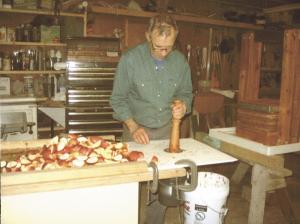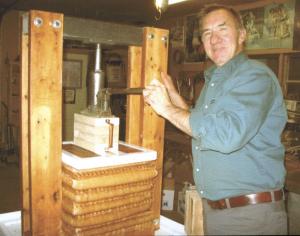Cider System Makes Use Of Excess Apples
What better way to dispose of excess apples than by making them into cider? Bruce Chandler built a hydraulic jack-powered press to squeeze out the juice. His first step to making great cider is to run it through a garbage disposal set up specifically for that purpose.
"The better job you do crushing the apples, the more juice you get," explains Chandler. "Running them through a garbage disposal just soups them."
His garbage disposal mounts on the underside of a sheet of plywood. Chandler simply cut a hole in it to fit the disposal unit. A piece of 1 1/4-in. plastic pipe comes off the bottom of the disposal in an L-shape and shoots the minced apples into a food-grade bucket.
"If we were going to sell cider, I would rebuild the work area using stainless steel or Formica, but this works fine for us," he says.
Chandler built his press using two pairs of 3-ft. long 2 by 6-in. boards for uprights and a 28-in. long 4 by 4-in. bridge to press the jack nose against. To keep the jack from pressing into the wood, the underside of the bridge is covered with a metal plate.
The uprights are bolted to the 4 by 4-in. bridge and to a 16-in. square, 4-in. high base. The entire press sits in a plastic shower base that Chandler bought new.
The ground-up apples are poured out on sheets of muslin cloth. The sides are folded over to make a square pad about 16 in. square. Squares of cloth-covered pomace are alternated in a stack with plywood separators on the press. Stacking continues until there is only room for the hydraulic jack and a 2-in. high, 16-in. square press base.
"I cut 3/4-in. thick, 16-in. plywood squares with a dado blade set to cut 1/2 in. deep, and at 1/2-in. spaces," explains Chandler about his separator boards. "Then I flip the boards over and cut channels perpendicular to those on the first side. This leaves 1/2-in. deep grooves on both sides with a waffle board pattern of 1/2-in. holes for the juice to run along and through."
All wood parts, including the separator boards, the press base and uprights, are sealed with paraffin to keep apple cider from soaking in. Chandler suggests warming the wood and the brush before applying the melted wax. Having everything warm encourages the hot wax to spread out and coat the wood.
When he cranks on the jack handle to squeeze out the juice, cider runs out into the basin and through its drain into containers.
"The amount we get depends on the type of apples and how juicy they are," he says.
Chandler advises letting the cider sit in containers for about 24 hours before siphoning off the juice. This leaves any sediment behind. He then mixes juice from different varieties to get the flavor he prefers.
"We raise 8 varieties of apples, but our favorite mix is Early Gold and State Fair, which are sweet, with Spartan, which is medium tart," says Chandler.
Contact: FARM SHOW Followup, A.B. Chandler, P.O. Box 253, Big Arm, Montana 59910 (ph 406 849-5678; sweett@in-tch.com).

Click here to download page story appeared in.
Click here to read entire issue
Cider System Makes Use Of Excess Apples FARM HOME Food 31-1-28 What better way to dispose of excess apples than by making them into cider? Bruce Chandler built a hydraulic jack-powered press to squeeze out the juice. His first step to making great cider is to run it through a garbage disposal set up specifically for that purpose.
"The better job you do crushing the apples, the more juice you get," explains Chandler. "Running them through a garbage disposal just soups them."
His garbage disposal mounts on the underside of a sheet of plywood. Chandler simply cut a hole in it to fit the disposal unit. A piece of 1 1/4-in. plastic pipe comes off the bottom of the disposal in an L-shape and shoots the minced apples into a food-grade bucket.
"If we were going to sell cider, I would rebuild the work area using stainless steel or Formica, but this works fine for us," he says.
Chandler built his press using two pairs of 3-ft. long 2 by 6-in. boards for uprights and a 28-in. long 4 by 4-in. bridge to press the jack nose against. To keep the jack from pressing into the wood, the underside of the bridge is covered with a metal plate.
The uprights are bolted to the 4 by 4-in. bridge and to a 16-in. square, 4-in. high base. The entire press sits in a plastic shower base that Chandler bought new.
The ground-up apples are poured out on sheets of muslin cloth. The sides are folded over to make a square pad about 16 in. square. Squares of cloth-covered pomace are alternated in a stack with plywood separators on the press. Stacking continues until there is only room for the hydraulic jack and a 2-in. high, 16-in. square press base.
"I cut 3/4-in. thick, 16-in. plywood squares with a dado blade set to cut 1/2 in. deep, and at 1/2-in. spaces," explains Chandler about his separator boards. "Then I flip the boards over and cut channels perpendicular to those on the first side. This leaves 1/2-in. deep grooves on both sides with a waffle board pattern of 1/2-in. holes for the juice to run along and through."
All wood parts, including the separator boards, the press base and uprights, are sealed with paraffin to keep apple cider from soaking in. Chandler suggests warming the wood and the brush before applying the melted wax. Having everything warm encourages the hot wax to spread out and coat the wood.
When he cranks on the jack handle to squeeze out the juice, cider runs out into the basin and through its drain into containers.
"The amount we get depends on the type of apples and how juicy they are," he says.
Chandler advises letting the cider sit in containers for about 24 hours before siphoning off the juice. This leaves any sediment behind. He then mixes juice from different varieties to get the flavor he prefers.
"We raise 8 varieties of apples, but our favorite mix is Early Gold and State Fair, which are sweet, with Spartan, which is medium tart," says Chandler.
Contact: FARM SHOW Followup, A.B. Chandler, P.O. Box 253, Big Arm, Montana 59910 (ph 406 849-5678; sweett@in-tch.com).
To read the rest of this story, download this issue below or click
here to register with your account number.








